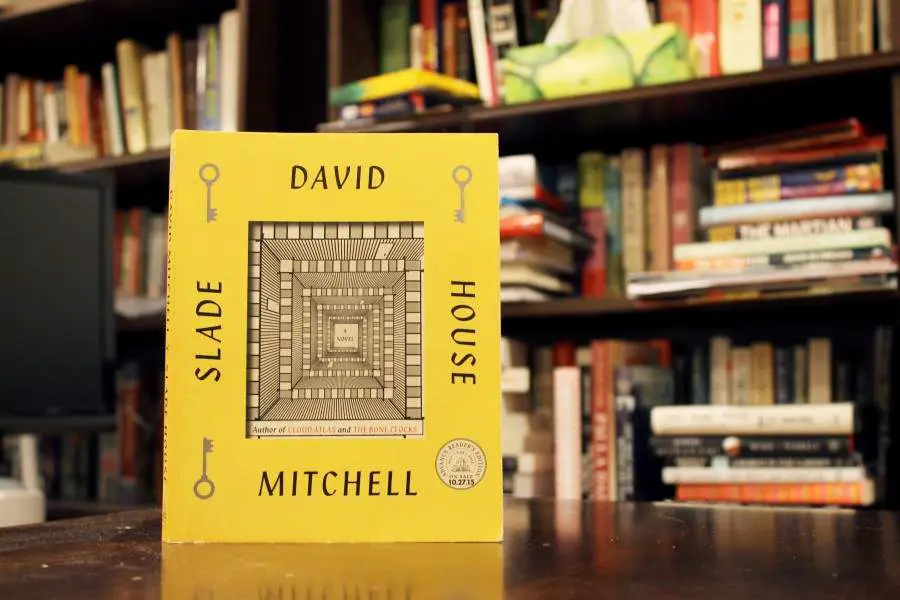Slade House
David Mitchell
Random House
Release Date: October 27, 2015
ISBN 978-0-8129-9868-9
David Mitchell is an amazing novelist (NPR reviewer Jason Sheehan calls his writing “beautifully twisty.” I like that.) With unique works such as Cloud Atlas and The Bone Clocks under his belt, the question is, what does he do next?
The answer is Slade House, a slim book housing a horror story that, true to David Mitchell’s style, echoes themes and ideas from earlier works (specifically, The Bone Clocks), twists and turns around itself, and in this case, brings chills to readers.
Slade House grew out of a short story, “The Right Sort”, that he wrote in 2014 on Twitter (that’s right – on Twitter: 280 tweets of 140 words or less); it became the first section of the novel. “It [the short story] was writing a long, fast string of pulses rather than looking down on the narrative with a slower, more leisurely view,” Mitchell said in a 2015 interview for the Miami Herald. “I found that it was asking more questions than it was raising. In the end, I couldn’t resist translating it back to more conventional prose, oxygenating it more than Twitter was allowing me to.”
Let’s be glad he did; Slade House is a truly scary (not gory – scary) read, one that can be read in one sitting, or savored (if one likes to savor scary tales) in sections – five sections, in fact, set nine years apart. In the first section, thirteen year old Nathan Bishop is finagled into accompanying his mom to a musical soiree that is being held at Slade House, the town residence of aristocratic Lady Grayer. Mrs. Bishop, an out of work, divorced pianist, hopes to make contacts there that may lead to a job; Nathan has taken two of his mother’s Valium, so he doesn’t really care much about anything. For his mother, the afternoon exceeds all of her expectations (Yehudi Menuhin wants to hear her rendition of Debussy on the pianoforte!); for Nathan, it moves from interesting, to perplexing, to downright terrifying.
That first section sets the stage, and introduces factors that will be echoed in later sections: grimy The Fox and Hounds tavern, a meeting – sometimes by chance, sometimes planned – that is a precursor to the rest of the section, the unexpected/foreboding/confusing approach to the Slade House address through a dingy and dark side way known as Slade Alley, the sudden appearance of a small -very small – black iron door that seems to be the only entry way into the residence’s grounds, which doesn’t open to just anyone’s touch, only those who are “gifted”. What appears beyond that black iron door is different in each section, but what occurs there follows a spiraling pattern that we as readers can see develop, but to which the players are oblivious until too late (if at all). We want to scream, “don’t do it – it’s a trap!”, but of course, they can’t hear us. We can only “watch” in horror as each section moves towards its seemingly inevitable end.
Each section takes place exactly nine years after the one preceding it (the reason for this quickly becomes clear). Each one offers an interlacing plot, with a different tailor-made nightmare, leading to an inevitable rending conclusion.
It is 1979 when Nathan Bishop and his mother pass through the black iron door to disappear into Slade House. In 1988, Inspector Gordon Edmonds vanishes while checking out a new lead in the Bishop disappearances. In 1997, a group of students calling themselves the Paranormal Society meet at The Fox and Hounds Tavern to investigate “the Slade Alley disappearances” and are never seen again. In 2006, a reporter meets with a possibly crazed old man who says he has information about the “X Files Six” (as the missing students have come to be known); one of which was the reporter’s younger sister, but – as with her sister – the reporter vanishes without a trace. In 2015, psychiatrist Dr. Iris Marinus-Fenby (whose name should be familiar to readers of The Bone Clocks), author of academic papers on abduction psychoses, is lured to Slade Alley by the promise of being able to see an actual operating orison (a kind of reality bubble). What she finds on the other side of the black iron door is perhaps that most startling of all.
The voice of the narrator in each section – doped up (and possibly autistic?) Nathan Bishop, lonely, racist Detective Edmonds, naive, tender-hearted student Sally Timms, etc. – are each distinct, each achingly real, each so very human. For each of them, Slade House appears at first not only as non-threatening, but as a kind of timely wonderland, holding such promise that even finely honed suspicions are chipped away at until defenses are dropped. What is offered within Slade House is hope – for stability, for love, for notoriety, for redemption – and that hope is the very ointment that ends up catching each of them like flies in a spider web.
Chilling – and entertaining. We as readers are safe in our own homes, in our own familiar lives; but if you ever find yourself in a place where your senses whisper that something is wrong even as they respond to it beckoning you onward, think of Slade House. You may decide, no matter how enticing what lies beyond may appear, to beat a hasty retreat, if you can. Wait too long, and like those who disappeared behind that black iron door in that dark, dingy alley, you may never be seen again.
~ Sharon Browning

